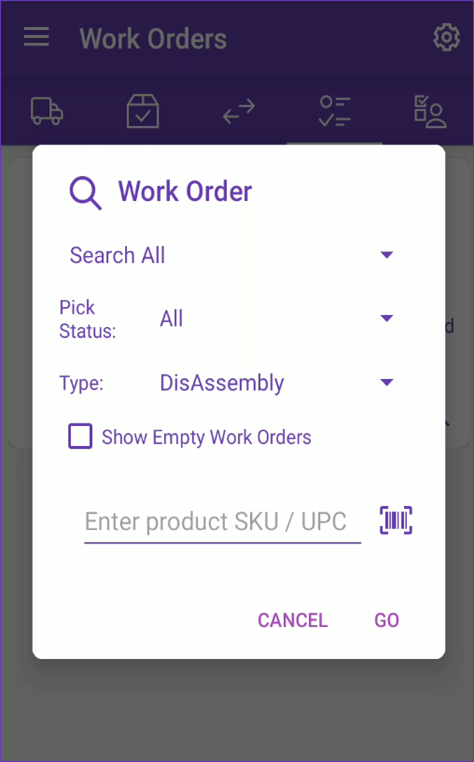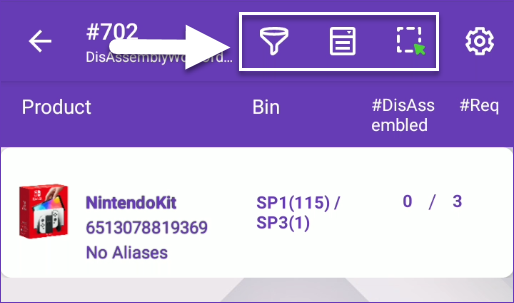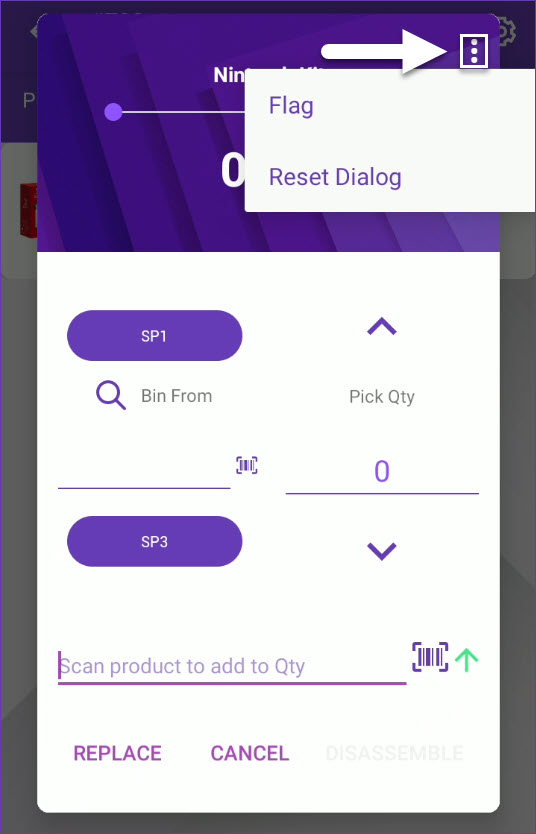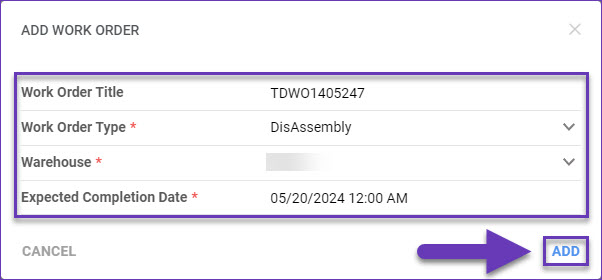Overview
The kit disassembly process entails breaking down kits into their components. When there is a need to take apart independent kits for any reason, the tasks can be efficiently assigned to your employees through Disassembly Work Orders. This method ensures that each disassembly is clearly defined and systematically distributed among your workforce, streamlining the overall inventory management.
Creating Disassembly Work Orders is only possible through the Skustack Admin portal, while managing existing work orders can be done through the Skustack app.
Disassembly Work Orders
The Work Orders module is located within Skustack’s Work Orders tab and allows you to search for open work orders, pick items, and disassemble kits.
Search Work Orders
You can search for Disassembly Work Orders in one of three modes:
- Search By Work Order ID – Opens a single Work Order using the internal Sellercloud ID.
- Search By Title – Opens a single Work Order using its title.
- Search All – Searches for all Work Orders. You can filter by Type – DisAssembly and narrow down the search results even further by searching for a specific SKU/UPC or Pick Status.
Pick by – Kit Parent or Kit Component.
Status – Defaults to all. You can choose from one of the available statuses:- All
- Zero Picked
- Partial Picked
- Zero or Partial Picked
- Fully Picked
Type – Defaults to all. Select DisAssembly.
SKU/UPC – A convenient option to search for all work orders associated with a particular product.
Manage Work Orders
Distributed Disassembly Work Orders can be completed in a few simple steps:
- Open the desired task and select a Destination Bin for the disassembled components.
- Next to the task ID, you’ll find several icons that allow you to:
- Filter – Refines the list of displayed products by:
- Status – Filter by the product’s picked status.
- Region – If your warehouse is organized by Regions, you can choose one from the dropdown list.
- Select Product Identifiers to Display – Choose the product identifiers to be displayed in the work order:
- UPC
- Aliases
- Product Name
- Destination Bin – The destination bin for the disassembled components.
- Filter – Refines the list of displayed products by:
- Swipe the header down to see the total number of items and view the task notes.
- Swipe a product to the left to reveal shortcuts to other actions:
- Bins – Tap the icon to see all bins where the product is stored (bins will show only if you’re logged into a bin-enabled warehouse).
- Info – Tap to be directed to the Product Info module.
- Product Flag – Tap on this icon to add a Product Flag.
- Scan the ProductID/UPC, or select the item on the screen. The product will open.
- Scan/enter a picking bin, or select one of the suggested bins. The suggestion is based on the following factors:
- The bin is sellable.
- The bin type is Normal or Temp.
- Primary bins will always be suggested first.
- The bin with the most or least quantity will be suggested based on the client setting PickList Bin suggestion sort qty by ASC Order.
- Scan units to add to the picked qty or adjust the number manually. To auto-populate the total quantity available for the scanned product in that bin, enable Skustack’s Warehouse Management setting Auto populate progress quantity when bin is selected.
- Tap on the three dots menu in the upper right-hand corner to:
- Flag – Flag the item and indicate specific concerns.
- Reset Dialog – Remove selected data from the picking dialog.
- If the parent product quantity is depleted, you can tap Replace and choose a replacement product.
- If the Lot Number workflow is enabled for your company and the product is set as expirable, you must select a lot number from the list of existing lot numbers on the parent:
- If that particular lot number had been assembled, then Skustack will automatically recognize the component’s expirable definition and which lot numbers to add back to which components.
- If that lot number had not been assembled (example: positive adjustment), then you will be prompted to select a lot number for each expirable component, or create new lot numbers for the components if they do not yet exist.
- Tap Disassemble. The kit will be broken down into its individual components and transferred to the chosen Destination Bin.
Related Settings
| SETTING | DESCRIPTION |
| PickList Bin suggestion sort qty by ASC Order | Client setting. Once enabled, the suggested bin to pick from will be the one with the lowest product quantity. |
| Auto populate progress quantity when bin is selected | Skustack’s Warehouse Management setting. When a bin is selected, the Pick Qty field will automatically be set to the total quantity available in that bin, up to the quantity required. |
Disassembly Work Orders
The Skustack Admin portal enables you to easily create new work orders, as well as manage existing ones.
Create Work Orders
To create a new Disassembly Work Order:
- Navigate to the Skustack Admin portal at https://xx.skustack.com (replace “xx” with your server ID or team name).
- Enter your login credentials.
- On the left, select Work Order and click on the + icon.
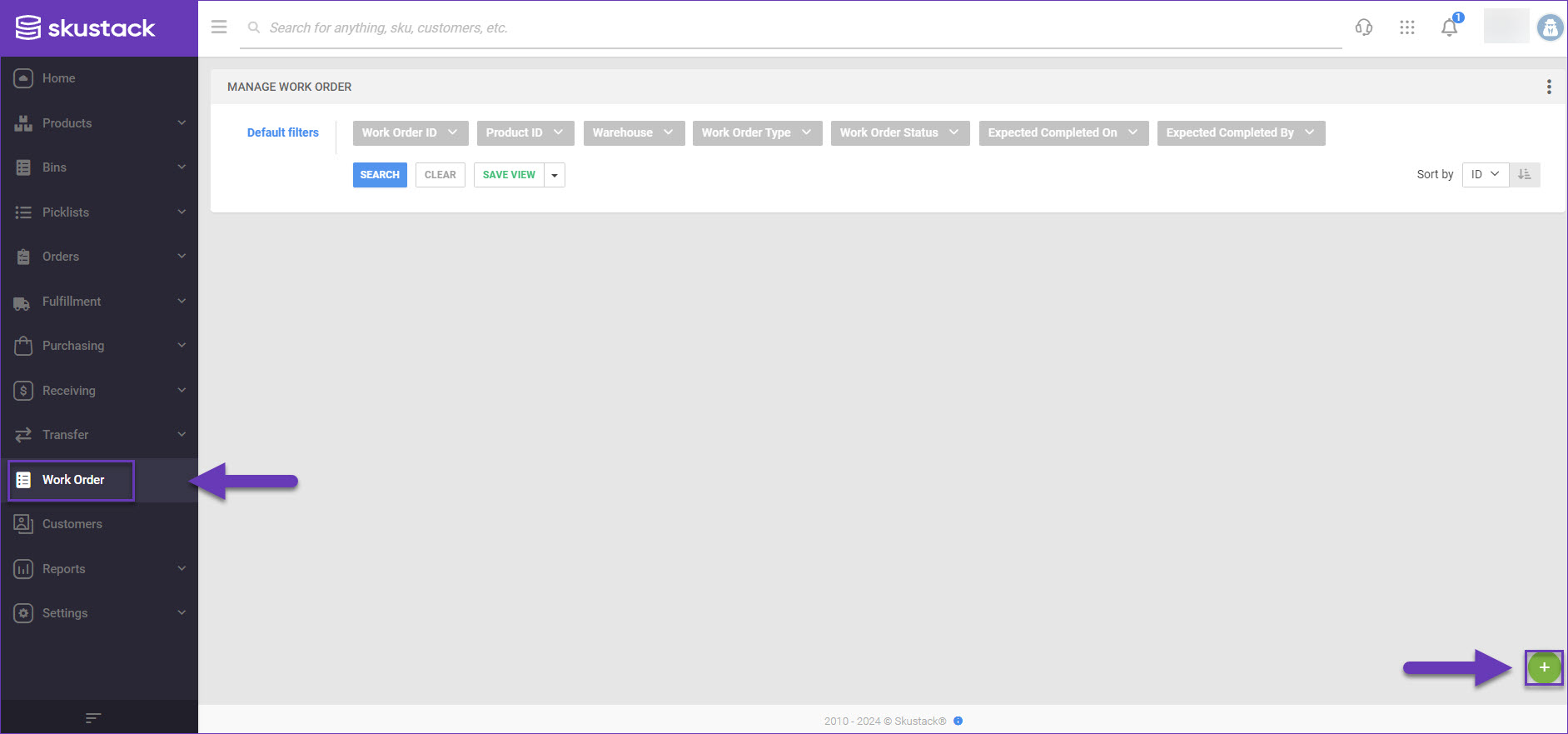
- Enter the following details:
- Work Order Title
- Work Order Type – DisAssembly
- Warehouse
- Expected Completion Date
- Click Add, and the new Work Order will load on your screen.
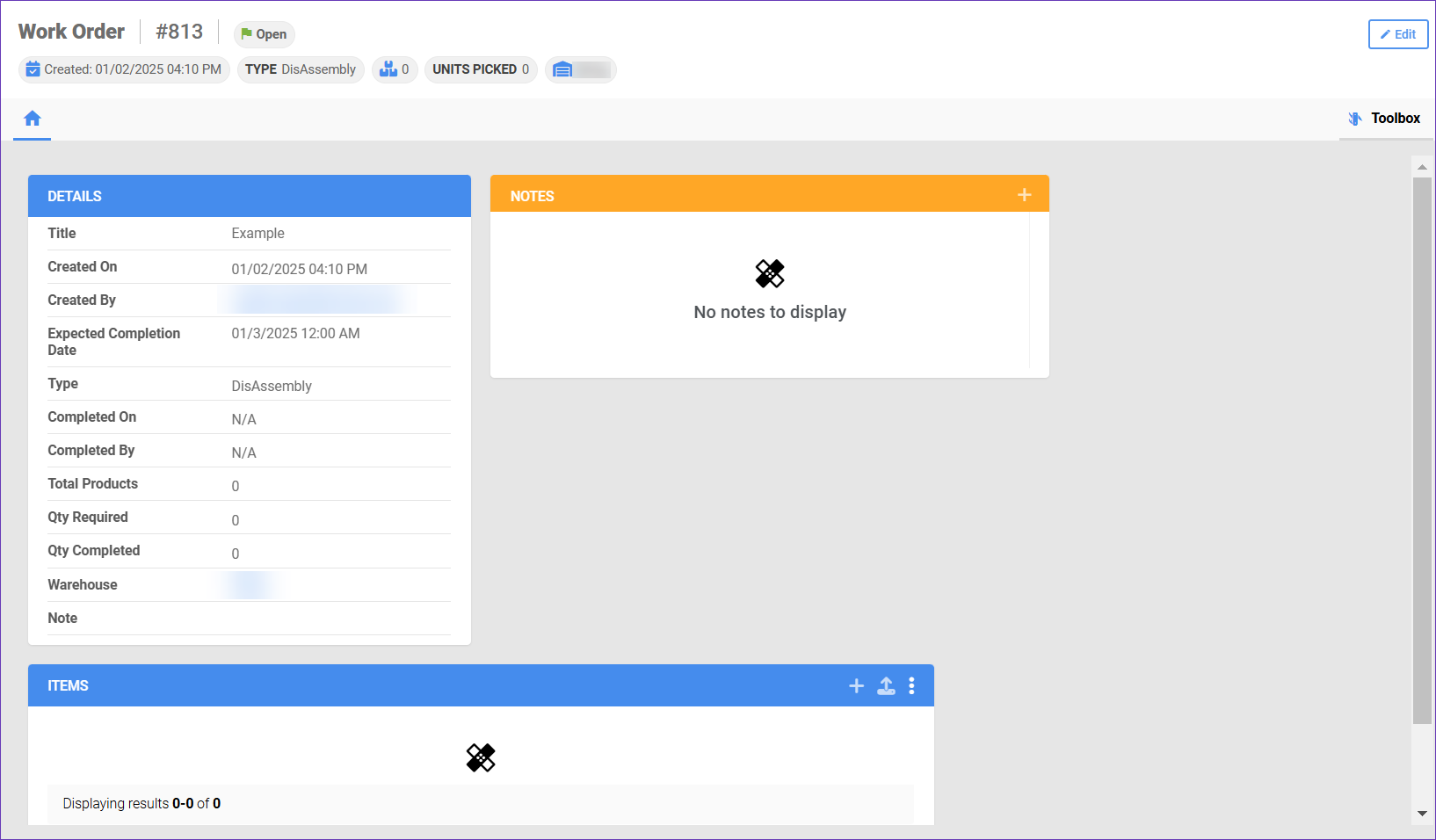
- (Optional) Add Notes with any custom requirements or additional information. Users you tag will receive the note as a notification in the Admin Portal and in Sellercloud’s Delta interface.
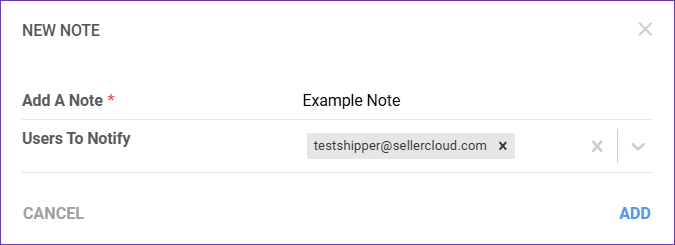
- In the Items panel, you’ll find two methods to add products to the Work Order:
- By searching and adding specific products.
- Via a Bulk Import.
Add Items
Next, proceed to add parent kit/s to disassemble either individually or in bulk.
Individually
- In the Items panel, click on the + icon.

- For efficient search results, the Is Kit filter is enabled by default for all Work Orders of type Disassembly. Search for the required kits by entering their SKUs, separated by commas.
- Select one or multiple products from your search results by checking the respective checkbox and populating the required quantity in the Qty field.
- Click Add Selected and proceed with the selection, or click Add Selected and Close, if done.

- The chosen products will appear in the Items panel.
In Bulk
- In the Items panel, click on the Bulk Import icon.

- Click Download Template and select a location to save the file.

- Open and populate the Excel file:
- ProductID – Add the SKU of the kit that you intend to disassemble.
- WarehouseName – Enter the name of the warehouse, for which the work order applies.
- TotalQtyRequired – Insert the number of items to add.
- Once all required products have been added, save the file and return to the Bulk Upload prompt.
- Add the saved file and click Upload and the products will appear in the Items panel.
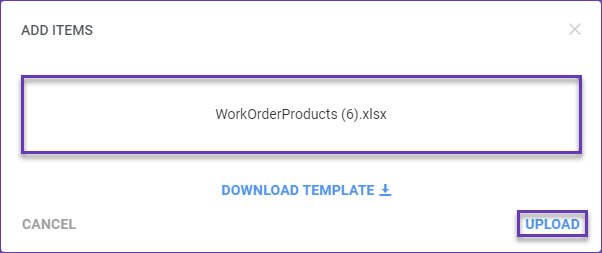
Manage Work Orders
In this section, you will learn how to manage your existing work orders in the Skustack Admin. In addition to creating new work orders, you can also:
- Search – By work order number, type, and status.
- Edit Items – Enter task notes, add new products to the work order, or delete existing ones.
- Delete – Permanently delete work orders.
- Close – Irreversibly changes the work order status to Closed.
- Export – Work orders to either Excel or PDF format.
Search Work Orders
To search for existing Disassembly tasks in the Skustack Admin:
- Navigate to the Work Order menu.
- Configure your Default filters to ensure that the results display exactly what you need and select DisAssembly as the Work Order Type.
- Click Search. Each filter you apply gets highlighted. If a filter is gray or not displayed at all, it’s not active.
- To manage the columns in the grid, click the three dots icon on the top right and select Customize Columns. You can:
- Reorder columns by dragging them up or down in the list;
- Hide columns by clicking the Trash icons;
- Add columns by clicking Add column.
- To arrange the data in a different order, use the Sort by menu.
- To save your filtering and sorting options, click Save view, enter a Name, and click Save.
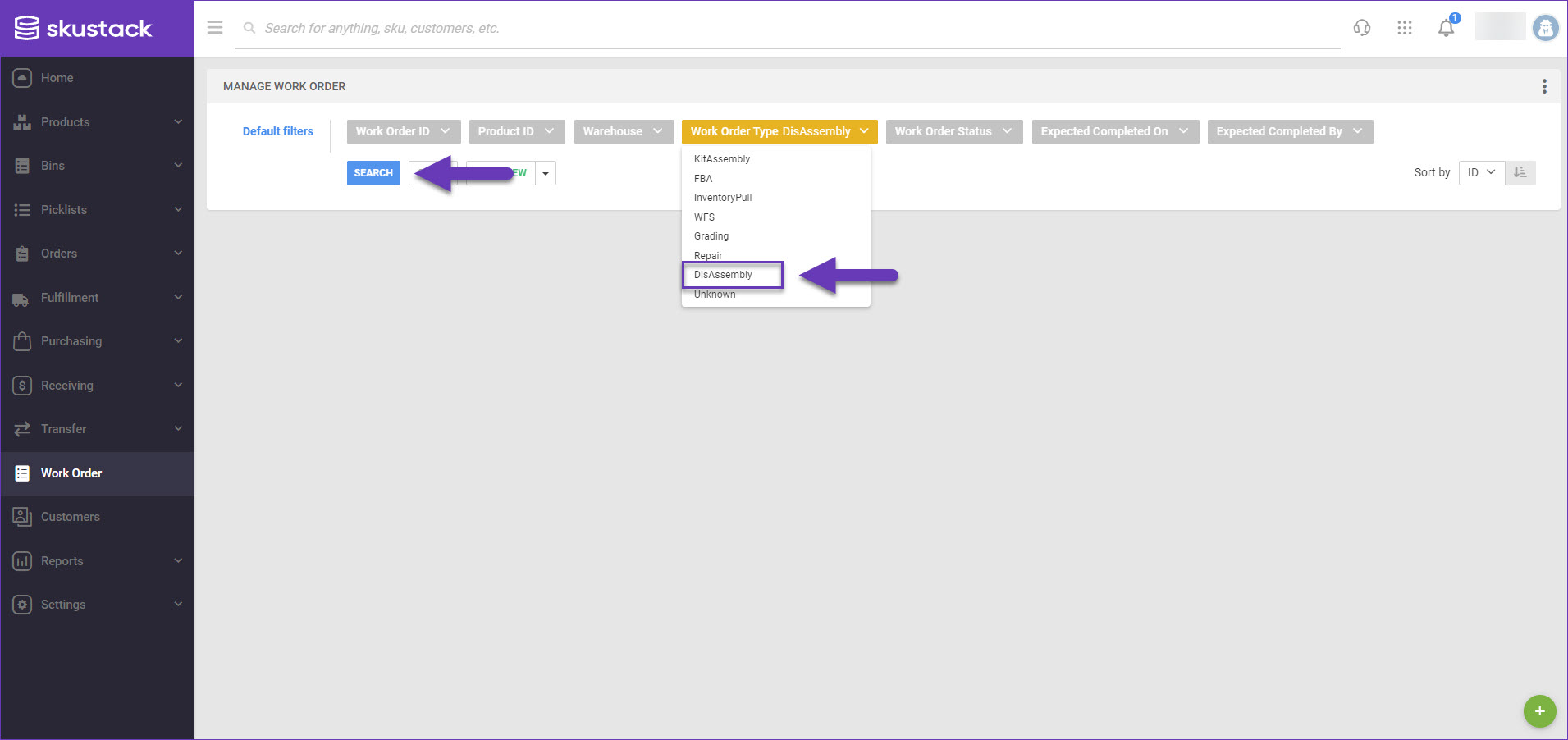
Edit Work Orders
To edit an existing work order, follow these steps:
- Open the desired work order.
- Click Edit.

- If necessary, you can add a task Note in the Details panel.
- In the Items panel, you can update the Qty Required or use the trash can icon to delete an item.
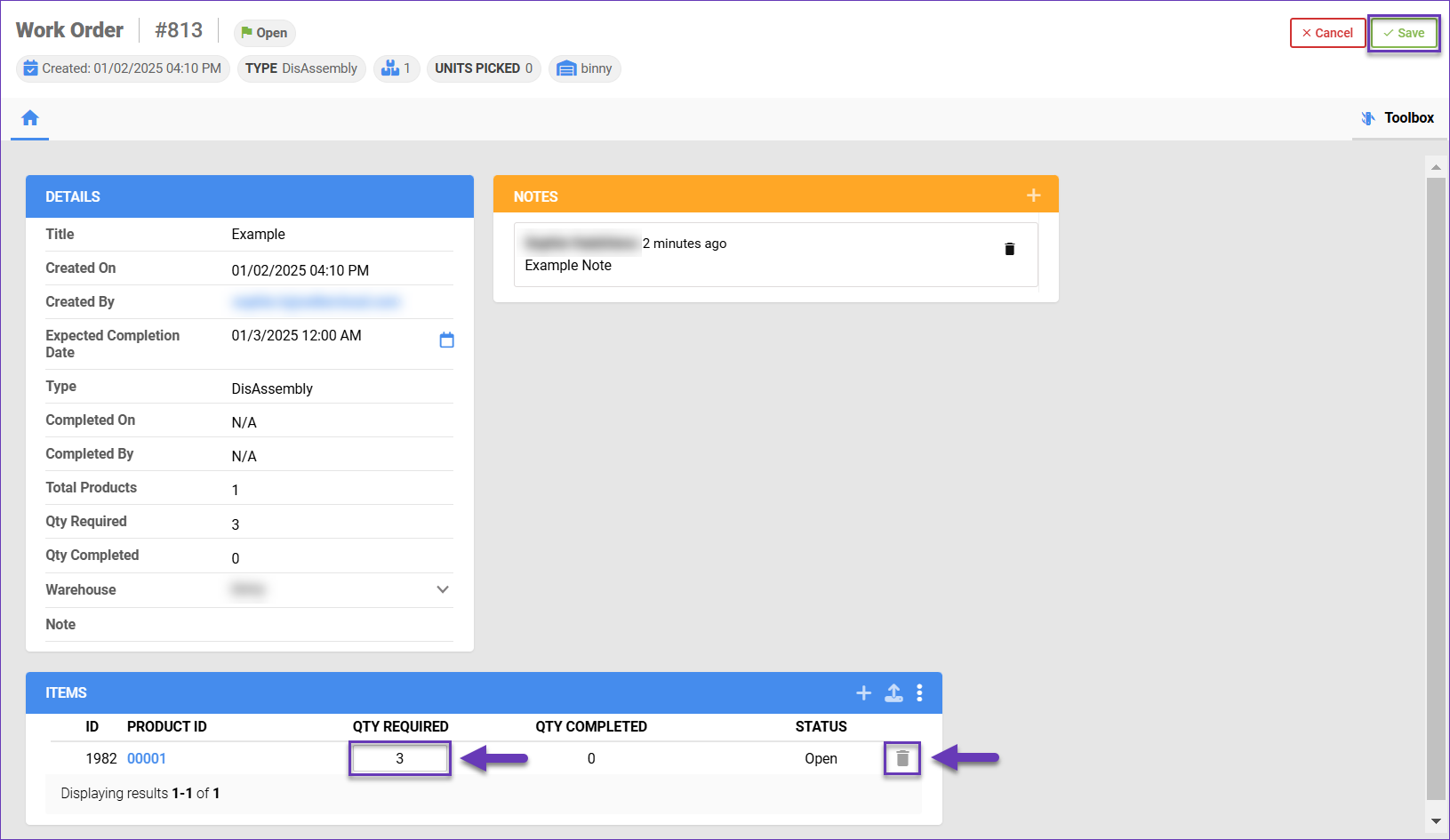
- Once done, click Save.
Close or Delete Work Orders
To close or delete work orders, follow these steps:
- Navigate to the Work Order grid.
- Search and select your desired work orders.
- Access the Actions menu.
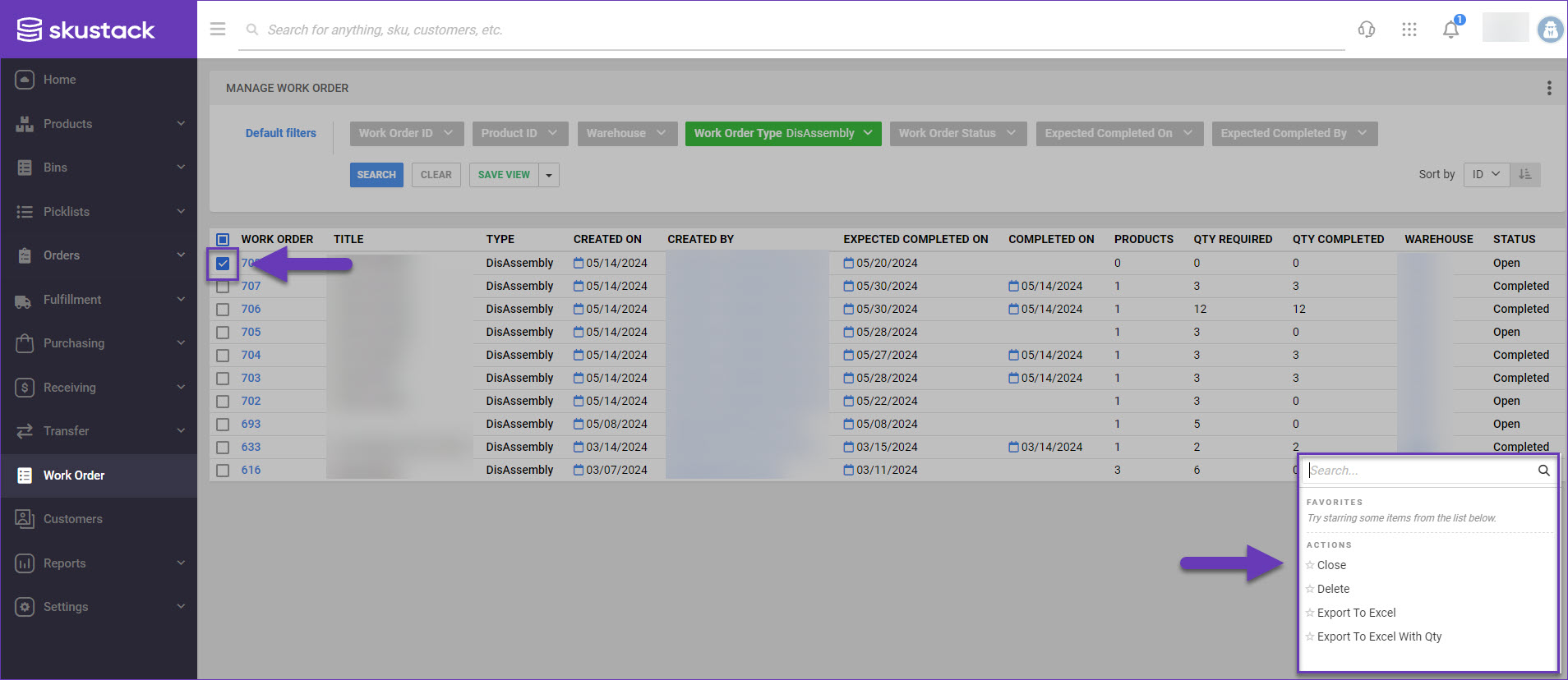
- Click Close to update the status to Closed or Delete* to delete work orders.
Export Work Orders
Generating a document that includes the ID and item details of the work order can help ensure that the instructions are clear and easy to read. This can simplify the process of distributing the task to Skustack users within your warehouse.
Individual work orders can be exported either in a PDF or Excel format through the three dots menu on the Items panel.
Bulk Export
You also have the alternative of exporting multiple work orders simultaneously:
- Navigate to the Work Order grid.
- Search and select your desired work orders.
- Access the Actions menu and select either Export To Excel, or Export To Excel With Qty.

- The file will be exported to your Downloads folder.
